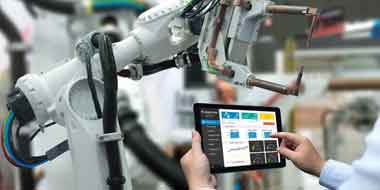Industries
AI & Industry 4.0 beyond the hype : putting AI into practice
12/02/2019 | Written by: Marloes Roelands
Categorized: Industries
Share this post:
Artificial Intelligence (AI) can be a real value driver for organizations. As the power of algorithms, computing and amounts of data surge, companies within manufacturing and industry start to see an increasing amount of use cases. These systems could drive efficiency and enhance capability. But also automatize tasks, decrease costs and improve revenue.
Success and value generated by AI benefit from a good understanding and expectation of what the technology can deliver from the C-suite down. Organizations in general should also have a well-considered implementation process. This concludes IBM in the recently published white paper on AI. ‘Beyond the hype: A guide to understanding and successfully implementing artificial intelligence within your business’.
Putting AI into Practice : Specific tasks
AI is not about sentient robots and magic boxes. AI is a science and a set of computational technologies. These are inspired by the ways people use their nervous systems and their bodies to sense, learn, reason and take action. But typically operate quite differently. AI encompasses machine learning (machines that can learn from data – algorithms adjusting themselves) and deep learning (a combination of algorithms that are mutually linked).
Within AI data scientists extract knowledge and interpret data by using the right tools and statistical methods. The machines learn to recognize patterns in the data that it is fed to them. And map these patterns to future outcomes.
Implementations
Relevant AI use cases span various areas across virtually every industry. But there are three main macro domains that continue to drive the adoption as well as the most economies across businesses. Cognitive engagement involves how to deliver new ways for humans to engage with machines. Cognitive insights and knowledge addresses how to augment humans who are overwhelmed with information and knowledge. And cognitive automation relates to move from process automation to mimicking human intelligence, to facilitate complex and knowledge-intense business decisions.
Below are some examples of successful implementations within the industrial and manufacturing domain:
- Using the many different available sensor measurements from large truck engines, a neural network at a manufacturer is trained to recognize normal and abnormal engine behavior. The model is able to detect when specific measurements were out of the ordinary. Anomalous sensor readings are highly predictive of pending engine failures.
- At a car manufacturer through supervised learning techniques predictive models were developed that could provide an early warning of failure based on the different system messages and sensor readings that continuously stream from the production line. This early warning could be used to prioritize maintenance and reduce both downtime as well as false positives and needless efforts.
- The output of machine learning-based predictive models with prescriptive, mathematical optimization models was used at a utility company to prescribe the optimal mix of power production sources to meet predicted demand and to minimize costs. This required both the prediction of demand as well as prediction of available solar and wind energy capacity.
- To understand the business dynamics and create inventory of possibly relevant data sources a material producer used machine learning models to learn the price behavior and forecast future price development. The models also enabled buyers to evaluate their own ‘what if’ scenarios. This all came together for the user in an interactive dashboard.
There are three main steps to implement AI:
- Develop an AI strategy and roadmap
- Establish AI capabilities and skills
- Start small and scale quickly
In the previously mentioned white paper IBM provides some practical recommendations to avoid frequent pitfalls such as cultural or managerial resistance, bad or insufficient data, too high or low expectations, lack of capabilities et cetera.
Based on its experience and knowledge, IBM can help to successfully implement AI and guide organizations in the transformation to Industry 4.0. IBM enables companies to experiment with big ideas, acquire new expertise and build new enterprise-grade solutions for immediate market impact. It gives companies the speed of a start-up, at the scale and rigor of an enterprise. For more information, please read the white paper or visit our website.

Associate Partner at IBM
The Digital Operational Resilience Act for Financial Services: Harmonised rules, broader scope of application
The Digital Operational Resilience Act – what and why As part of the European Commission’s Digital Finance Package, the new Digital Operational Resilience Act, or in short DORA, will come into force in the coming period. The aim of DORA is to establish uniform requirements across the EU that improve the cybersecurity and operational resilience […]
Banking on empathy
Suppose you’re owning a small boutique wine shop and have gone through two difficult years because of the Covid-19 pandemic. As the pandemic seems to be on its way back, it is time to revitalize the shop. And this causes direct a huge challenge: the wine stock needs to be replenished but you have used […]
Één platform voor alle EAM-data
Het ideale onderhoudsmoment aan een zonnepannelfarm bepalen op basis van de weersvoorspelling, een snelle en nauwkeurige kwaliteitscontrole op een productielijn uitvoeren, een defect aan een pijpleiding voorspellen of de veiligheid op de werkvloer verbeteren. Het kan allemaal met IBM Maximo Application Suite (MAS). De nieuwste versie van dit Enterprise Asset Management-platform (EAM) is uitgebreider […]


